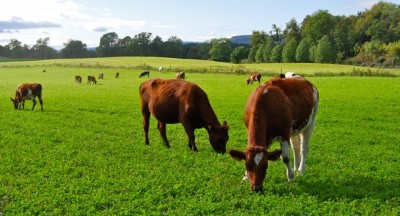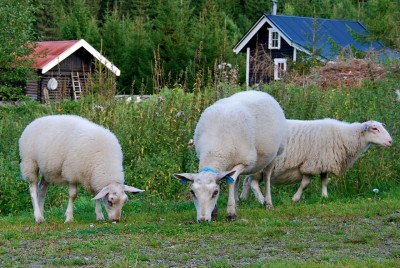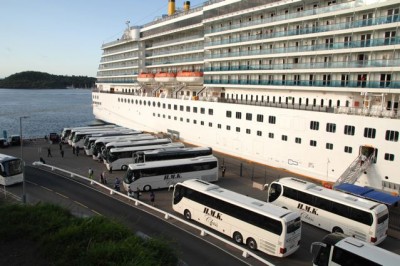Norwegian authorities eased their strict protectionist policies this week when they finally lowered import tariffs to offset a sudden shortage of butter. Otherwise, though, protectionism is alive and well, with Norwegian lamb and tour bus companies the latest to avoid competition from cheaper foreign providers.

The butter shortage has riled customers, especially bakers on the eve of the big holiday baking season. It’s been almost impossible to find ordinary butter on the shelves of Norwegian grocery stores in recent weeks, with dairy giant Tine blaming everything from the weather to lower milk production and higher consumer demand caused by a low-carbohydrate diet fad.
Others blame Tine for poor planning. Officials of the dairy cooperative that dominates the market in Norway finally felt compelled to ask state agricultural authorities, who normally protect Tine and their dairy farmers, to reduce the tariff on butter from abroad. Tine realized that otherwise, there would be a shortage of around 50 tons of butter a week in Norway through December, when demand is at its highest.
That threatened to make Tine highly unpopular. The dairy coop already had cut its cheese production in order to boost butter production, but supplies of milk are so low that it wasn’t enough.
On Tuesday the authorities went along with the request, slicing the tariff (called toll in Norwegian) from the usual NOK 25.19 per kilo to just NOK 4 for the entire month of December. That should mean that imported butter, or butter locally made from imported products, will be on the shelves by next. Tine’s smaller rival dairy products maker Synnøve Finden had its plans ready to import butter from Belgium. Synnøve Finden doesn’t make butter itself but has an annual import quota of 260 tons that it now will use.

While the Norwegian authorities were allowing some relief to consumers of butter, though, they have tightened restrictions in two different areas: Lamb meat imports and tour bus operations. The new restrictions on imports of lamb meat from poor countries have raised questions of double standards.
Norway’s left-center government coalition, which includes the highly protectionistic and farmer-friendly Center Party, scored some anti-poverty points a few years ago when it promoted boosting imports of lamb from producers in Africa. Newspaper Aftenposten reported this week that the government wasn’t happy that only 0.3 percent of Norway’s total meat imports came from poor countries that Norway wanted to help.
So Namibia in southern Africa, on the list of countries able to import without being subject to tariffs or quotas, concentrated on the Norwegian market. Exports from Namibia to Norway jumped from 43 tons in 2008 to 288 tons in 2009. Imports reached 239 tons just during the first six months of last year, but then the Norwegian authorities cracked down.
‘Would have hurt Norwegian production’
To protect local sheep ranchers, exporters in Namibia will now be unable to send their meat to Norway once they pass 400 tons, even though that only amounts to 1.6 percent of Norwegian production. “Norwegian lamb is important, therefore we had to set a limit,” Magnar Sundfør in the agricultural ministry told Aftenposten. “Otherwise Namibian exporters could have sent thousands more tons here, and that would have hurt Norwegian production.”
Asked whether it didn’t ruin the aid effort by cutting off imports as soon as Namibian sheep ranchers were seeing some returns on their business, Sundfør said “no, because Namibia and Botswana are not among the world’s poorest countries.”
Halvor Mehlum, economics professor at the University of Oslo, scoffed at the authorities’ defense of their policies to protect Norwegian farmers at the expense of those in Namibia. “The deal had looked good on paper, but as soon as the positive effect in Africa challenges Norwegian interests, advantages to the poor are reduced,” Mehlum told Aftenposten.

Norwegian tour bus operators are the next to win protection from foreign competition. They’ve also won their campaign to restrict foreign tour bus operators from offering their services in Norway to just 30 days in a row and 45 days over the course of an entire year.
The Norwegian bus companies clearly felt threatened by foreign companies that could operate at lower cost. They were allowed, under European free trade regulations, to operate in Norway but only for midlertidig (temporary) periods. The definition of “temporary” wasn’t clear, so now the Norwegians are setting it at the 30- and 45-day limits.
That’s aimed to reduce the number of foreign operators who’ve been grabbing sizeable shares of, for example, the market to transport cruiseship passengers on ground tours. A new website where bus operators must register is expected to help Norwegian police and transport authorities to make sure the foreigners obey the new rules that take effect from April 1.
Views and News from Norway/Nina Berglund
Please support our stories by clicking on the “Donate” button now:

